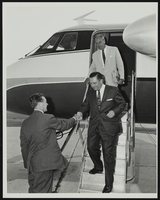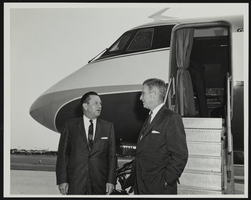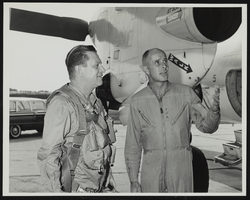Search the Special Collections and Archives Portal
Search Results
Series V. Hughes Tool Company, 1912 to 1990
Level of Description
Scope and Contents
The Hughes Tool Company series (1912-1990) encompasses the administrative, financial, and legal management of Hughes Tool Company. Materials within the series depict Howard Hughes' control of the company; his film, aeronautics, electronics, and real estate ventures; and his lawsuits and United States Senate hearing. The series also includes research reports on the corporate history of Hughes Tool Company and its subsidiaries, copyright histories for films Hughes produced, and correspondence from Hughes' associates searching for reels of Hughes' films domestically and internationally.
Archival Collection
Collection Name: Howard Hughes Film Production Records
Box/Folder: N/A
Archival Component
#71630: New student orientation sessions held in the Student Union on July 7, 2017, 2017 July 07
Level of Description
Archival Collection
Collection Name: University of Nevada, Las Vegas Creative Services Records (2010s)
Box/Folder: Digital File 01
Archival Component
New York-New York Hotel and Casino 9-11 Heroes Tribute Collection
Identifier
Abstract
The New York-New York Hotel and Casino 9-11 Heroes Tribute Collection consists of materials from the "Heroes of 9-11" display that was at the New York-New York Hotel and Casino in Las Vegas, Nevada from 2001 to 2012. The materials primarily consist of more than 5,000 t-shirts left at the memorial by visitors to Las Vegas, mostly from fire departments and law enforcement agencies from around the United States. Visitors left shirts and other items at the memorial as a sign of respect for the men and women who died during the terrorist attacks in New York City and Washington, D.C. on September 11, 2001. The collection also houses memorabilia and other items left at the memorial, including flags, hats, pins, buttons, flowers, and embroidered emblems and insignias. The materials also contain documentation of the memorial, including promotional and press materials, video recordings from the news media, photographs, and newspaper articles.
Archival Collection
Hughes/Echostar Video News Release Corporate Announcement- New Master, 2002 March 07
Level of Description
Archival Collection
Collection Name: Hughes Electronics Corporation Records
Box/Folder: Box 14
Archival Component
Global Works Hughes Electronic Corporation Corporate Runner New AO, 2000 October 23
Level of Description
Archival Collection
Collection Name: Hughes Electronics Corporation Records
Box/Folder: Box 16
Archival Component
Hughes HK-1 Hercules photographs, 1942-1947
Level of Description
Scope and Contents
Materials contain photographs of the HK-1 Hercules, otherwise known as the "Spruce Goose" or the "Flying Boat," from 1942 to 1947. The photographs primarily depict the construction, transportation, and storage of the plane, but also include photographs of the first and only test flight of the HK-1 above Los Angeles Harbor in 1947. Howard Hughes designed the HK-1 as the world's largest plane, capable of transporting large quantities of U.S. military hardware and personnel. In 1947, under the program's new designation H-4 Hercules, Hughes had the plane transported from his factory in Culver City, California to Los Angeles Harbor. On November 2, he piloted the plane during its only test flight. The U.S. Air Force abandoned the controversial project, and Hughes was called to testify before the Truman Committee of the U.S. Senate to justify the use of government funds on a program that never succeeded.
Archival Collection
Collection Name: Howard Hughes Professional and Aeronautical Photographs
Box/Folder: N/A
Archival Component

Howard Cannon visits Grumman Aircraft Engineering Plant at Bethpage, Long Island, New York: photographic print
Date
Archival Collection
Description
Image

Howard Cannon visits Grumman Aircraft Engineering Plant at Bethpage, Long Island, New York: photographic print
Date
Archival Collection
Description
Image

Howard Cannon visits Grumman Aircraft Engineering Plant at Bethpage, Long Island, New York: photographic print
Date
Archival Collection
Description
Image
Hughes XF-11 photographs, 1946-1947
Level of Description
Scope and Contents
Materials contain photographs of the Hughes XF-11 prototype military reconnaissance aircraft from 1946 to 1947. The photographs depict Howard Hughes piloting the two XF-11 prototypes that were built: during the test flight in July 1946, Hughes crashed the first XF-11 in Beverly Hills, California; in April 1947, Hughes successfully flew the second prototype at high speeds and at high altitudes. However, the United States Air Force abandoned the controversial project, and in August of 1947, Hughes was called to testify before the Truman Committee in the U.S. Senate about the failures of the program.
Archival Collection
Collection Name: Howard Hughes Public Relations Photograph Collection
Box/Folder: N/A
Archival Component
